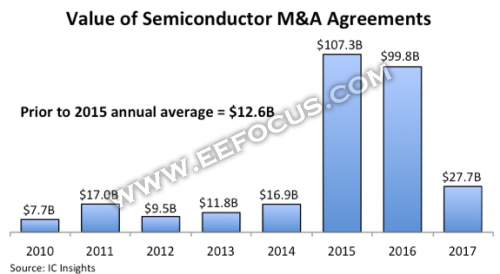A picture to see the past eight years of mergers and acquisitions in the semiconductor industry
In 2017, the semiconductor industry reached a number of small-scale M&A transactions, but large-scale deals could hardly be seen.
In 2015 and 2016, large and small mergers and acquisitions swept across the semiconductor industry, and the amount of mergers and acquisitions hit a record high. In 2017, mergers and acquisitions were substantially reduced. However, according to the latest report issued by ICInsight this month, the amount of M&A transactions in 2017 is still more than twice the average amount of M&A transactions between 2010 and 2015.
In 2017, about 24 M&A transactions were concluded between semiconductor companies, involving a total of approximately $27.7 billion in business units, product lines, and related assets. This compares to $99.8 billion in 2016 transactions, which was achieved in 2015. A record 107.3 billion US dollars. Prior to the climax of this round of semiconductor acquisitions, the annual average merger and acquisition transactions between 2010 and 2015 amounted to approximately US$12.6 billion.

In the 2017 M&A transaction, the two large-scale transactions accounted for 87% of the total transaction amount. Without the blessings of these two transactions, the whole year 2017 will be a bad year for mergers and acquisitions. The significant slowdown in M&A activity in 2017 shows that the madness of mergers and acquisitions in the previous two years has finally cooled down. In 2015, as the growth of various major end markets (smartphones, PCs and tablets) slowed, more and more companies began to purchase other chip businesses to offset the decline in these market growth rates and expand their business to In a huge emerging market, this led to the outbreak of mergers and acquisitions boom. These emerging markets include the Internet of Things (IoT), wearable systems, and highly intelligent embedded electronic products, including those that will emerge in new cars in the near future. Automatic driving assistance and fully automated driving system.
Due to the reduction in the number of M&A targets and the increase in business integration, the M&A transactions completed in 2017 have been significantly slowed down. The regulatory review of mergers and acquisitions by European, U.S., and Chinese government regulators has also slowed down the pace of large-scale mergers and acquisitions in the semiconductor industry.
Compared with the previous two years, a major difference in 2017 is that there are far fewer major deals. In 2017, only two mergers and acquisitions worth more than 1 billion US dollars (Toshiba Semiconductor business transaction amounted to 18 billion US dollars, Marvell plans to purchase Cavium for 6 billion US dollars). In 2015, there were 10 M&A deals worth more than US$1 billion and in 2016 there were seven. Throughout 2017, the average amount of the semiconductor M&A agreement was US$1.3 billion. If these two large-scale transactions were excluded, the average amount would be only insignificant US$185 million. In contrast, according to data compiled by IC Insight, the average amount of 12 semiconductor acquisition activities reached in 2015 was 4.9 billion US dollars, and the average transaction amount of 29 M&A activities in 2016 was 3.4 billion US dollars.
Ms001 3000Puffs Vape,Mini Electronic Cigarette,Vape Electric Cigarette,Electronic Cigarette Vape Puff Bar
Guangzhou Yunge Tianhong Electronic Technology Co., Ltd , https://www.e-cigaretteyfactory.com